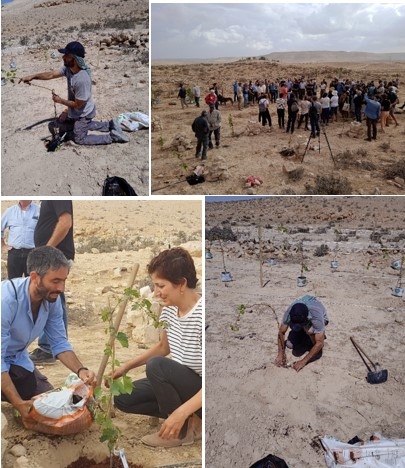Daniel Fuks, Research and Public Engagement – 2023
In September 2023, I had the honor of participating in the planting of a 1300-year-old variety of grapes on the outskirts of the UNESCO world heritage site, Avdat. My previous research demonstrated the significance of viticulture in this region during Late Antiquity. Grape pips that I retrieved from excavations led by Dr. Tali Erickson-Gini (Israel Antiquities Authority) and Prof. Scott Bucking (DePaul U.)
at Early Islamic Avdat were DNA sequenced and identified to variety in a study led by Dr. Meirav Meiri, Dr. Pnina Cohen (Tel-Aviv U.) and Prof. Guy Bar-Oz (U. Haifa): Ancient DNA from a lost Negev Highlands desert grape reveals a Late Antiquity wine lineage | PNAS. In September, those same varieties were planted at the site for the first time in over 1,000 years! Perhaps they are genetically better-adapted to this desert environment, with potentially significant value for viticulture on
a warming Earth. The planting was conducted with support of an ERC proof of concept grant awarded to Bar-Oz. Lior Schwimer (BGU and Nature and Parks Authority) oversaw the planting. 
*********
In May 2022, colleagues and I founded the Crop History Consortium (CHC), a cross-disciplinary group aiming to conduct and promote interdisciplinary synthesis research on crop histories, with a focus on the last 2,000 yrs in the Middle East and Mediterranean. Among key milestones attained in 2023, the CHC: (1) hosted its first conference session at the European Archaeology Association (EAA) meeting in Belfast 2023, on “Interdisciplinary integration in reconstructing agricultural crop histories”; (2) was awarded its first grant aimed at facilitating CHC goals, a UKRI AHRC Networking Grant awarded to Michelle Alexander (U. York; PI) and me (co-PI); and (3) wrote its first joint paper, entitled “Orphan crops of archaeology-based crop history research”, published in Plants, People, Planet. For more on the paper and the CHC, see: https://www.arch.cam.ac.uk/news/orphan-crops
*********
To what extent do we owe our current diets to the Roman, Byzantine, and Early Islamic empires? A new study by Fuks et al. (2023) based on archaeological plant remains from the Negev Highlands –some of which provide the earliest evidence for eggplant, white lupin and domesticated jujube in the Levant – suggests that the effects of Roman Agricultural Diffusion (RAD), and first millennium CE agricultural change more generally, marked
an unprecedented period of long-distance crop diffusion. Nevertheless, the new crops did not markedly change local diets, supporting a gradualist model for agricultural change over the last 10,000 years. This is the first archaeobotany study published in the journal eLife.
Fuks, D., Melamed, Y., Langgut, D., Erickson-Gini, T., Tepper, Y., Bar-Oz, G. and Weiss, E. 2023. Unprecedented yet gradual nature of first millennium CE intercontinental crop plant dispersal revealed in ancient Negev desert refuse. eLife, 12: e85118.*********
As time capsules of past economies and ecologies, ancient feces, or coprolites, comprise a scarce but valuable archaeological resource. To make the most of the information encapsulated in this increasingly researched sample type, developing multi-proxy workflows has been a focus of my Marie S. Curie CroProLITE project. Over the past year this has led me to engage in analyses of various types, including micro-CT scanning (Fig. 1) at the U. Cambridge McDonald Institute for Archaeological Research Paleolab and at the Cambridge Zoology Department’s Biotomography Centre; proteomics extractions at the University of Copenhagen; ancient DNA extractions at the McDonald Institute’s Henry Wellcome Laboratory for Biomolecular Archaeology; and radiocarbon pretreatments at the 14CHRONO Centre in Belfast. The latter began as a set of experiments on minimally destructive radiocarbon dating of sheep/goat dung funded by a Tier 1 Cambridge Humanities Research Grant (CHRG). These experiments demonstrated the possibility of dating shavings of dung pellet exteriors, which is significant because it makes good use of an otherwise discarded source of contaminants (Fuks et al. 2023). To carry this work forward, I was recently awarded a Tier 2 CHRG for research aiming to confirm or qualify this result through a series of experiments on the consistency and reliability of radiocarbon dates obtained from this material.
Fuks,D.,O’Neill-Munro,N., Reimer, P.J., Erickson-Gini, T., Bar-Oz, G., Galili, R., Bucking, S. 2023. Minimally destructive radiocarbon dating of caprine dung. Radiocarbon, 65(4):832–847.
https://doi.org/10.1017/RDC.2023.70
Fig. 1 Dung pellets from Early Islamic Nahal Omer, northern Aravah valley, Israel.
Left: Intact dung pellets (photographed by Daniel Fuks); Right: micro-CT generated 3D model of a dung pellet with seed inside (produced by Guiseppe Castelli, U. Cambridge)